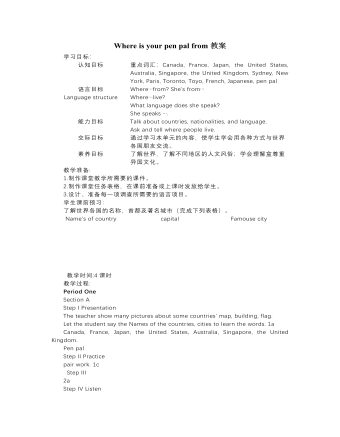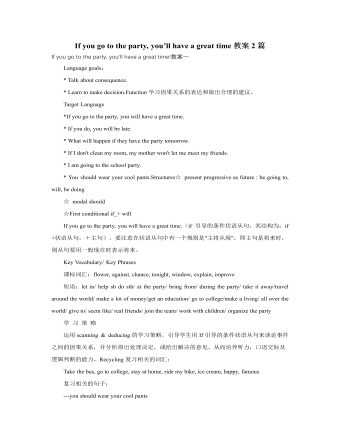人教版新目标初中英语七年级下册Where is the post office教案2篇
-
- 页数:7页
- 字数:约 11944 字
- 大小:101.00KB
- 格式:.doc
- 版本:Office2016及以上版本
- 作者:墨韵浅月
Where is the post office教案2篇
Where is the post office教案一
I. Teaching analysis
In this unit, students will learn how toexpress the location, how to ask and show the ways. In the course ofconversations, well also review the usage of prepositions and there be.Improve the abilities of solving problems by doing the tasks. The content ofthis unit is close to life, and it is very practical, students will beinterested in it. But it is also a little hard to some lower students, soteacher should pay attention to the difficulty degrees when designing thetasks, to fit different students.

II. Teaching targets
1. Knowledge and abilities
Learn how to ask and show the ways, and candescribe the place.
2. Process and methods
Learn the prepositions by introducing ones’ own family district. Practicing asking and showing the ways byimitated asking ways activities.
3. Moral education
Learn asking for help politely. And alwaysget ready to help others.
III. Important and difficult points
Important points:
1. How to ask for and give directions on thestreet.
2. Describe what there is in some place.
Difficult points:
1. Using the way to ask for and givedirections on the street.
2. Describe some place.
IV. Teaching method
Communication, and solving task methods.
V. Periods
First period: learn to describe the locationrelationship between one place and other buildings. (Learn the prepositions)
Second period: Learn how to ask the locationof one place. (Review the prepositions, learn adjectives and asking ways)
Third period: Learn how to show the ways tosome places. (Review the prepositions, adjectives and showing ways)
Fourth period: Can describe places.
VI. Task design

VII. Teaching steps
The First Period
Step 1: Greeting
Step 2: Show the new words in 1a.
T: If you want to borrow some books, you cango to the library. Do you know what library means? Can you make a sentence with“library”?
Step 3: Practice
Activity 1a.
Make a dialogue in pairs.
Sentences: Is there a ... in the picture?
Where is it?
Learn to use “in fount of, behind,next to, cross from”.
Step 4: Listening
Activity 2a & 2b.
Step 5: Game
Where is my best friend?
Let the students describe their best friendsand the rest of the students guess who he/she is. (See who has the mostfriends?)
Step 6: Homework
The Second Period
Step 1: Free talk
Discuss you school
Step 2:
Discuss the school. When describing thelocations, give them the adjectives.
Use: Is there a ...? Is it clean?
Step 3:
Task: I am the headmaster—design the ideal school
Group discussion; introduce the new schoolthat you have designed. Each group chooses the best one to report. And choosethe best design in class.
The Third Period
Step 1:
Task one: Look at the pictures and learn thesentences of asking the ways. (Section A 3a)
Step 2:
Task two: Find a student to turn right orleft or go straight according to the teacher’s order, to find thenext student that play the game.
Step 3:
Task three: Listening part of Section B 2a 2b
Step 4:
Task four: Invite the students to go to yourhome. And describe the route and draw a map. Mark some of the importantbuildings in the map.
The Fourth Period
Step 1:
Task one: Draw your home district, and introduceyour district.
Step 2:
Task two: Describe the route, Self check 3
Step 3:
Task three: Make a nice showing routebooklet. (Creative tasks)
read 3a & 3b→choose one place(park or mall street)→writearticles.
Where is the postoffice?教案二
Topic: Countries, nationalities, and languages
Functions: Talk about countries, nationalitiesand languages
Ask andtell about where people live
Structure: Wheres/Wherere ...from?
Where does/do ...from?
What questions----What language does/do...speak?
Target language: Where is she from?She isfrom....
Where does she live?She lives in....
What language does she speak?She speaks....
Vocabulary: words about countries, languages
Teaching design: The whole unit needs 5periods, 4 for new lessons and 1 for test
Period1 ( 1a----Grammar Focus )
Key points: Where is your/Johns pen palfrom?He/She is from...
Where does he/she live?He/She lives in....
(Homework for preview)Pre-task: Let the Ss givethemselves pen pals and they should write down their pen pals information,such as their names, countries and cities they live even the language theyspeak
T can give the Ss an example meanwhile T givesthe different countries which can be used by the Ss. T gives the Ss Chinesewords for the countries, they are following: 加拿大,法国,日本,美国,澳大利亚,新加坡,英国,中国( The Ss can look them up in the dictionary if they are new for them)
Theexample is following:
Name: Curry Muray
Age: 75
From(Nationality): the United States
City: New York
Language: English
Teaching Steps:
Step 1 Leading-inThe information of theteachers own pen pals information.
"I have a pen pal. His name is Curry Muray.He is from the United States. Do you have a pen pal? Where is your pen palfrom? Whats your pen pals name?"
Different students say the information abouttheir own pen pals. T should choose the different countries. T writes thedifferent countries on the Bb(both Chinese and English)
Step 2Learning
Section A 1a Learn the new words on the Bb. Thenew words are:
pen pal; Canada; France; Japan; the UnitedStates(the US/the USA/America); Australia; Singapore; the United Kingdom(theU.K./Great Britain/England)
Pay attention to the pronuciation of the new words.
Step 3 Listening
1b Listen and circle the countries in 1a theylearned
Step 4Competition
Two groups of students to write the new words tosee which group does better. First write down the Chinese words with looking atthe English meanings, then write down the English words with looking at theChinese meanings.
(This step is a memory game. It can help the Ssconsolidate the new words they learned)
Step 5 Pairwork
1c Practise the following conversation:
---Do you have a pen pal?---Yes, I do.
---Wheres your pen pals from?----He/She isfrom ....(Write it down on the Bb)
First T has a conversation with one student asan example then let the Ss practise in pairs. At last let several pairs do itagain in class.
Step 6Leading-in
Revise the countries names with looking at theBb. Then T writes down the city names on the Bb. Let the Ss try to find outwhich countries the cities are in. The city names are following:
Toronto; Paris; Tokyo; New York; Sydney;Singapore; London;
Step 7Learning
2aLearn the city names together with the wholeclass just like Step 2
2b Listenand circle the cities and countries
2c Listenand complete the chart
Have a similar competition to consolidate thenew words in this part.
Step 8 Pairwork
T has a conversation with one student like thefollowing:
---Do you have a pen pal?---Yes, I do.
---Whats your pen pals name? ---His/Her nameis....
---Where is your pen pal from? ---He/She isfrom...
---Where does he/she live? ---He/She livesin....(Write it down on the Bb)
Let the Ss practise after the Ts example inpairs then several pairs do it in class.
Step 9 Exercise
My pen pal is from Australia.(划线提问)
Johns pen pal is from Japan. (划线提问)
He lives in Paris. (划线提问)
Homework: Read and copy the new words .
Copy the sentences in Grammar Focus
Make up the questions about Jodie in 2c Thequestions are:
Does Jodie have a pen pal? Where is Jodies penpal from? Where does he/she live? Whats his/her name?(This one can be chosenby themselves)
Period 2 (3a----Section B 2c)
您可能喜欢的文档
查看更多
人教版新目标初中英语七年级下册Where is the post office说课稿3篇
- 页数:12页
- |大小:125.00KB

人教版新目标初中英语七年级下册Where is your pen pal from教案
- 页数:4页
- |大小:59.00KB

人教版新目标初中英语七年级下册Where is your pen pal from说课稿3篇
- 页数:12页
- |大小:154.50KB

人教版新目标初中英语七年级下册I’m watching TV教案
- 页数:6页
- |大小:61.50KB

人教版新目标初中英语八年级下册If you go to the party, you’ll have a great time教案2篇
- 页数:25页
- |大小:200.00KB

人教版新目标初中英语八年级下册What were you doing when the UFO arrived教案2篇
- 页数:12页
- |大小:106.50KB

人教版新目标初中英语七年级上册Is this your pencil教案
- 页数:18页
- |大小:94.00KB
热门课件教案

公司2024第一季度意识形态工作联席会议总结
- 页数:6页
- |大小:141.67KB
- 课件教案

XX区文旅体局2023年工作总结 及2024年工作安排
- 页数:8页
- |大小:32.41KB
- 课件教案

2023年区实施乡村振兴战略工作总结
- 页数:6页
- |大小:27.90KB
- 课件教案

县综合行政执法局2023年工作总结和2024年工作计划
- 页数:8页
- |大小:28.37KB
- 课件教案

关于2024年上半年工作总结和下半年工作计划
- 页数:5页
- |大小:29.72KB
- 课件教案

交通运输局在巡回指导组主题教育阶段性工作总结推进会上的汇报发言
- 页数:4页
- |大小:33.41KB
- 课件教案
今日更新

5月份主题教育工作情况总结汇报
- 页数:3页
- |大小:136.87KB

××县招商局2024年上半年工作总结
- 页数:12页
- |大小:142.54KB

×××公安局机关党委上半年党建工作总结
- 页数:7页
- |大小:186.25KB

《2019—2024年全国党政领导班子建设规划纲要》实施情况的工作总结3800字
- 页数:6页
- |大小:29.16KB

“转观念、勇担当、新征程、创一流”主题教育活动阶段性工作总结
- 页数:3页
- |大小:22.76KB

“四零”承诺服务创建工作总结
- 页数:5页
- |大小:39.83KB











